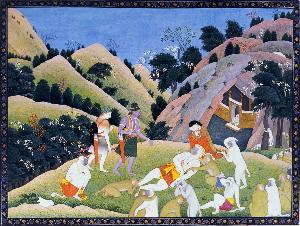Kangra Paintings
Kangra Paintings;Kangra School
Place: Kangra
Biography:
The Kangra painting style, named after the former princially state of Himachal Pradesh, has a rich history that dates back to the 18th century. Kangra Paintings is characterized by its unique blend of lyricism, rhythm, and intricate details, making it a distinct school of art.
History and Evolution
Kangra painting emerged as a prevalent form of art with the decline of the Basohli school of painting in the mid-18th century. This style soon gained popularity, producing a large volume of paintings that became known as Pahari painting school. The central theme of Kangra Paintings is the depiction of eternal love between Hindu deities Radha and Krishna. Key Features The Kangra miniatures are distinguished by their:
- Lyricism and spontaneous rhythm
- Softness and minute intricate details of composition
- Intense perception and portrayal of human emotions and physical features
Artistic Style and Influence
The Kangra painting style has been influenced by various artistic movements, including the Mughal and Rajasthani-Rajput schools. However, it has maintained its unique characteristics, making it a significant part of Indian art history. Basawan, a renowned artist, is known for his skilled use of color and portraiture in the illustrations of Akbarnama. Importance of Kangra Paintings Kangra paintings are not only a testament to the artistic skill of Indian artists but also a representation of the cultural and religious heritage of the region. The National Gallery of Modern Art in New Delhi, India, houses many of these paintings, including works by Raja Ravi Varma and Nandlal Boshu.
Conclusion
In conclusion, Kangra paintings are a unique and significant part of Indian art history. Characterized by their lyricism, rhythm, and intricate details, these paintings have become an essential part of the Pahari painting school. Kangra Paintings continue to be celebrated for their beauty and cultural significance, making them a treasured part of India's artistic heritage. https://Wikioo.org/@/Kangra-Paintings https://en.wikipedia.org/wiki/History_of_painting https://Wikioo.org/Art.nsf/Art_EN?Open&Query=kangra+paintings,kangra, paintings

